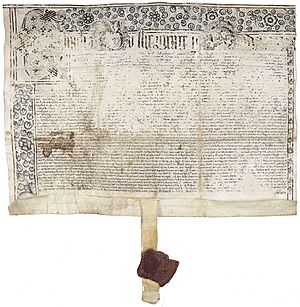Francis Wyatt facts for kids
Quick facts for kids
Sir Francis Wyatt
|
|
|---|---|
| Governor of Virginia | |
| In office November 1621 – 18 September 1625 |
|
| Appointed by | James I |
| Preceded by | Sir George Yeardley |
| Succeeded by | Sir George Yeardley |
| In office November 1639 – February 1641 |
|
| Appointed by | Charles I |
| Preceded by | John Harvey |
| Succeeded by | William Berkeley |
| Personal details | |
| Born | 1588 |
| Died | 1644 |
| Nationality | English |
| Occupation | Planter |

Sir Francis Wyatt (1588–1644) was an important English leader. He became the first royal governor of Virginia, an English colony in America. He sailed to America in 1621 on a ship called the George.
When he arrived in October, he became governor. He brought with him the first written rules, or constitution, for an English colony. This was a very important step for self-governance in the New World.
Contents
Sir Francis Wyatt's Life and Role
Sir Francis Wyatt was born in 1588 at Boxley Manor in Kent, England. His parents were Sir George Wyatt and Jane Finch. He studied at St Mary Hall, Oxford and Gray's Inn. In 1618, he was made a knight.
Governor of Virginia
Wyatt started his first term as governor of Virginia in November 1621. In 1622, Jamestown was attacked by Native Americans. Sir Francis helped organize the defense of the settlement. He then worked to make the colony's scattered outposts safer.
In 1624, Virginia became a "royal colony." This meant it was directly controlled by the King of England. Sir Francis stayed on as governor until September 1625. After this, Sir George Yeardley took over the role again.
Wyatt lived in Jamestown with his wife, his brother Haute, and their servants. After his first term, he returned to England.
Second Term as Governor
Sir Francis Wyatt was appointed governor of Virginia again in 1639. He served from November 1639 until February 1641. After him, Sir William Berkeley became governor.
During his second term, Wyatt arranged to buy a house for the governor. This became the first official "state house" for the colony. Before this, the government meetings were held in the church.
After his second term, Wyatt went back to England. He passed away in Boxley in 1644.
Creating Laws in Virginia
Sir Francis Wyatt played a key role in the General Assembly. This group had first met in 1619. It was the very first law-making body in America. Sir Francis made sure its rules were written down in a constitution. This was the first written constitution of its kind in the New World.
Sir Francis Wyatt's Family
Sir Francis Wyatt's wife was Margaret. Her father was Sir Samuel Sandys. Her uncle was George Sandys, who was the treasurer of Jamestown.
Francis and Margaret had several children. Their son Henry had a daughter named Frances. Another son, Edwin, later regained ownership of Boxley.
Sir Francis also had a younger brother, Reverend Hawte Wyatt (1594–1638). Hawte traveled to Virginia with Francis in 1621. He returned to England with him in 1624. Many people in America today are descendants of Reverend Hawte Wyatt. This includes the late Duchess of Windsor, who was married to Edward VIII, later known as the Duke of Windsor.

